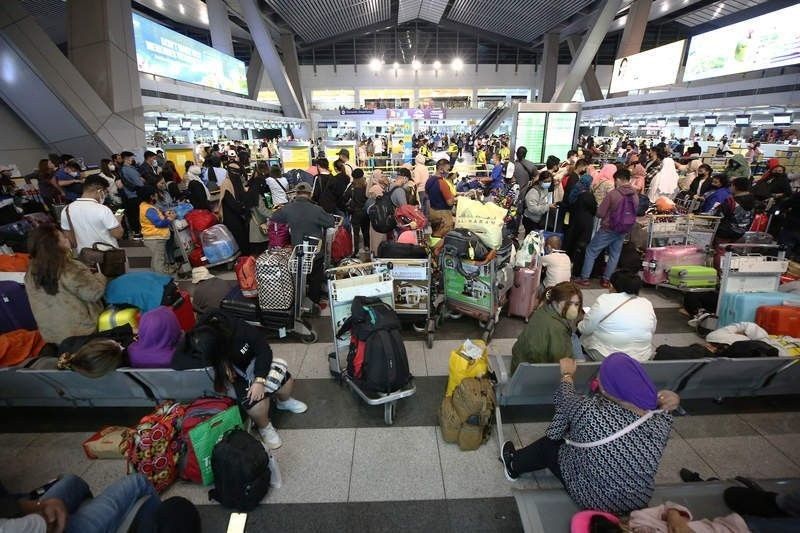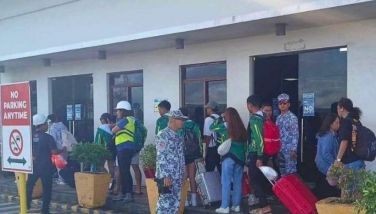Tugade camp: CAAP chief recommended air traffic system

MANILA, Philippines — The camp of former Department of Transportation (DOTr) secretary Arturo Tugade dismissed claims that the Communications, Navigation and Surveillance/Air Traffic Management (CNS/ATM) System of the Civil Aviation Authority of the Philippines (CAAP) was faulty, stating that it was the failure of backup power supply that caused the massive air travel disruption on New Year’s Day.
In a virtual interview on “The Chiefs” on One News Wednesday night, Tugade’s spokesperson, former transportation undersecretary Artemio Tuazon Jr. stated that the CNS/ATM was procured in 2018 upon the recommendation of current CAAP director general Manuel Antonio Tamayo, who was DOTr undersecretary for aviation and airports during Tugade’s time at the department.
Tuazon pointed this out as he expressed surprise over recent pronouncements of Tamayo that there was a need to procure a new CNS-ATM system for the country in the aftermath of the Jan. 1 fiasco.
“At the time... he was our undersecretary for aviation, our DG (director general) was Jim Sydiongco and they were joined there by attorney Danjun Lucas, their chief of staff,” Tuazon recalled, in a mix of English and Filipino. “They were the ones who recommended to Secretary Tugade to put that system, to buy it, to procure and install that CNS-ATM.”
“Why would they say now that the one installed was outdated. It was them, it came from them, they recommended it. They’re the technical people who evaluated it,” Tuazon said.
Tuazon stressed that the Jan. 1 fiasco was mainly caused by the failure of the Uninterrupted Power Supply (UPS) system of the CNS-ATM system to activate upon the power supply disruption at the Ninoy Aquino International Airport (NAIA) complex.
Needs upgrading
Transportation Secretary Jaime Bautista met yesterday morning with representatives from the Japan International Cooperation Agency (JICA) – who funded CAAP’s CNS/ATM System – and from the Thales group, a French multinational company that designs, develops and manufactures electrical equipment for aerospace, defense, transportation and security sectors.
JICA and Thales representatives assured Bautista that their systems are the latest and not “outdated but only need upgrading.”
CAAP said that the CNS/ATM System was a P10.8-billion project funded by JICA and completed in October 2017.
Previously, CAAP only used three radars to manage the Philippines’ air traffic. With the new system, the country now has 13 radars covering around 70 percent of Philippine airspace.
Additionally, with the introduction of the Automatic Dependent Surveillance–Contract and the Controller-Pilot Data Link Communications, the CNS/ATM will be able to cover 100 percent of oceanic airspace. The system was inaugurated on Jan. 16, 2018 and commenced operations July 26, 2019.
After delivering his arrival statement on his just concluded state visit to China yesterday, President Marcos was seen talking to Secretary Bautista, who is facing resignation calls over the air traffic system glitch that disrupted several flights at the NAIA.
Immediately after going down from the podium at Villamor Air Base, Marcos shook hands with Bautista and talked to him as Vice President Sara Duterte, First Lady Liza Marcos and Information and Communications Secretary Ivan Uy looked on.
It was not clear what their conversation was about but Marcos looked serious and appeared to be emphasizing a point using hand gestures while talking to the transportation chief.
The technical issues at the NAIA air traffic system delayed several flights on New Year’s Day, two days before Marcos left for China.
How come?
Sen. Joseph Victor Ejercito on Thursday said he is saddened that the airport fiasco happened despite the fact that Congress provided funds to ensure flawless operations of the airport.
“All of the things they have asked for – government support, subsidy, airport upgrades, equipment, navigational tools and everything, especially the equipment for the night flying capability of other airports – we already gave them. That’s why a lot of airports were already upgraded,” Ejercito said.
“That’s where I feel sad. Why, of all things that they have requested, why the main air traffic management system, how come we failed here?” he added.
Ejercito said he is hopeful that more information will be provided to senators as the Senate committee on public service chaired by Sen. Grace Poe is set to conduct investigation on the matter, in aid of legislation, on Jan. 12.
In Congress, opposition lawmaker Rep. Paul Daza said it may be time for the CAAP to avoid another potential conflict of interest separating its dual mandate of having both regulatory powers and commercial functions over all airports nationwide.
“The recent fiasco at the NAIA clearly signals the need to separate the regulatory and commercial functions of the CAAP. We could no longer afford another similar incident,” he warned, suggesting that CAAP “focus on being a regulatory body” and shed its commercial functions to avoid conflict.
Reforming CAAP, according to Daza, will “require filing of certain bills to ultimately and officially decouple the regulatory and developmental functions of the agency.”
“The CAAP must be enhanced to focus on being a regulatory body,” he said.
Another opposition legislator, Rep. Bernadette Herrera, called for Congress to conduct an investigation into the purported NAIA power outage that disrupted flights in the country.
Old advisory
For its part, the Office for Transportation Security (OTS) clarified that the photo circulating on social media of a public advisory from the United States Department of Homeland Security noting inadequate security at the NAIA was an old advisory issued in December 2018, and has since been removed from US airports.
OTS Administrator Ma.O Aplasca said Philippine airport authorities have continued working together with the US and other foreign counterparts to improve the overall status of security at the country’s international gateways.
In a joint assessment last August 2022, officials from the US Transportation Security Administration commended the OTS and other airport authorities for maintaining adequate security measures, emphasizing that the Philippines was the first country in Asia to have its advanced security screening technologies placed in strategic areas. – Rudy Santos, Delon Porcalla, Cecille Suerte Felipe, Alexis Romero
- Latest
- Trending





























